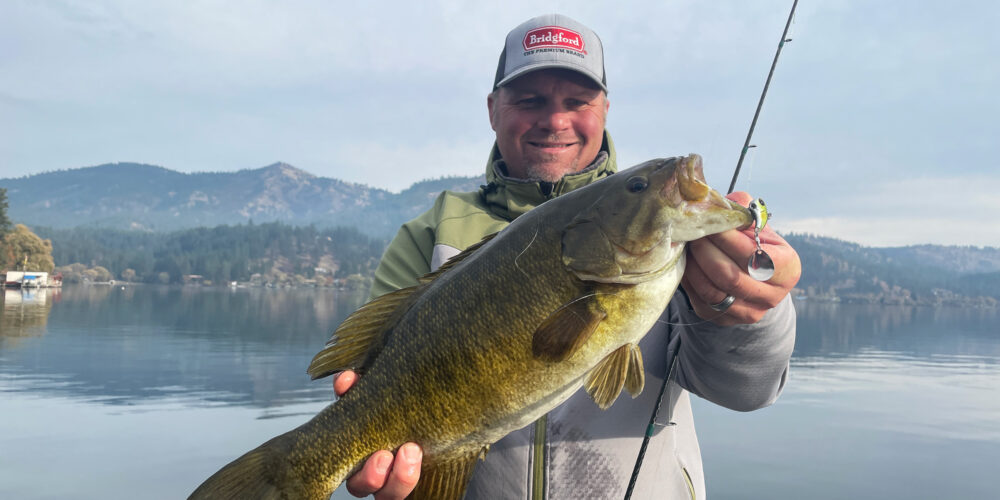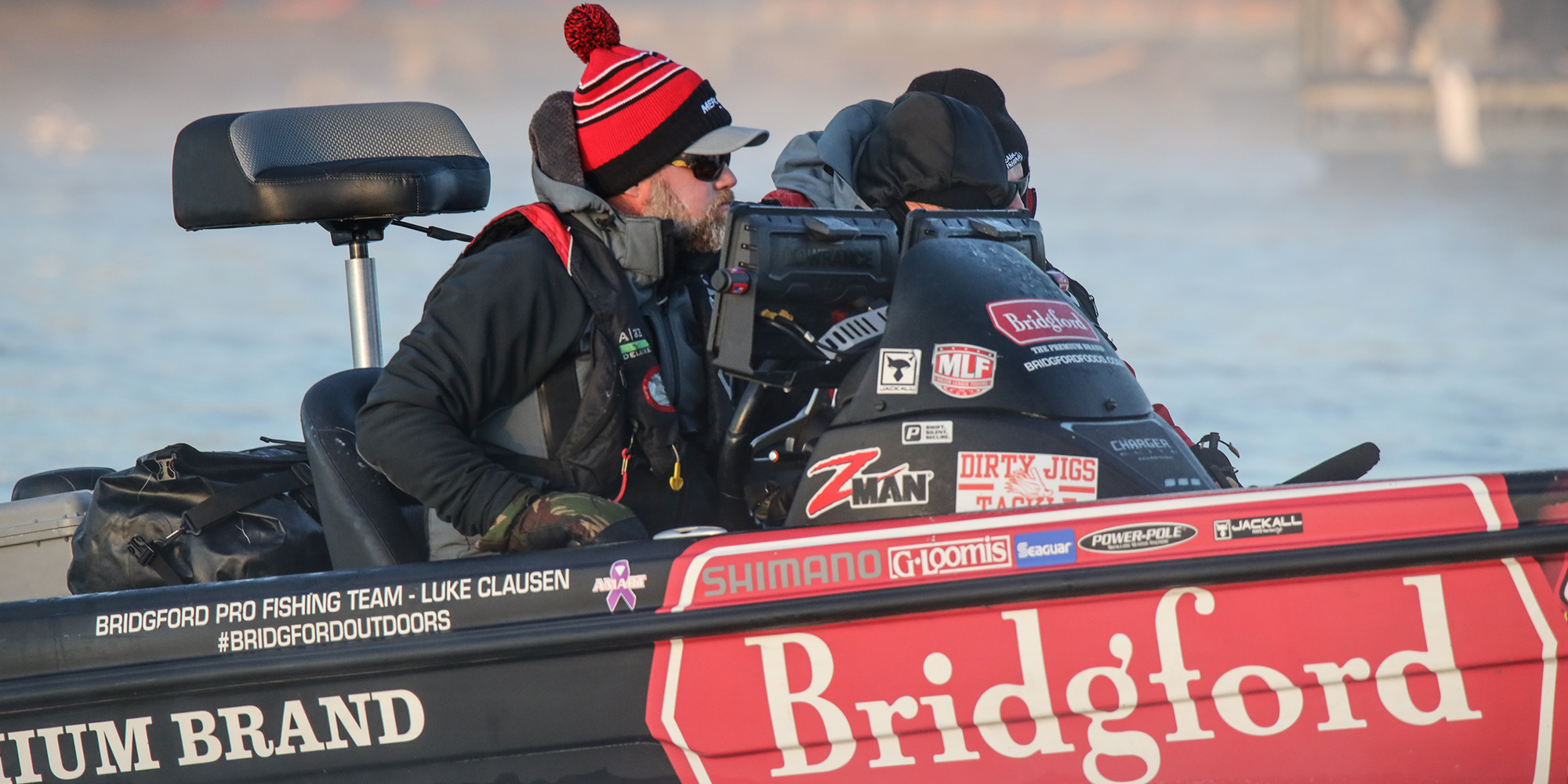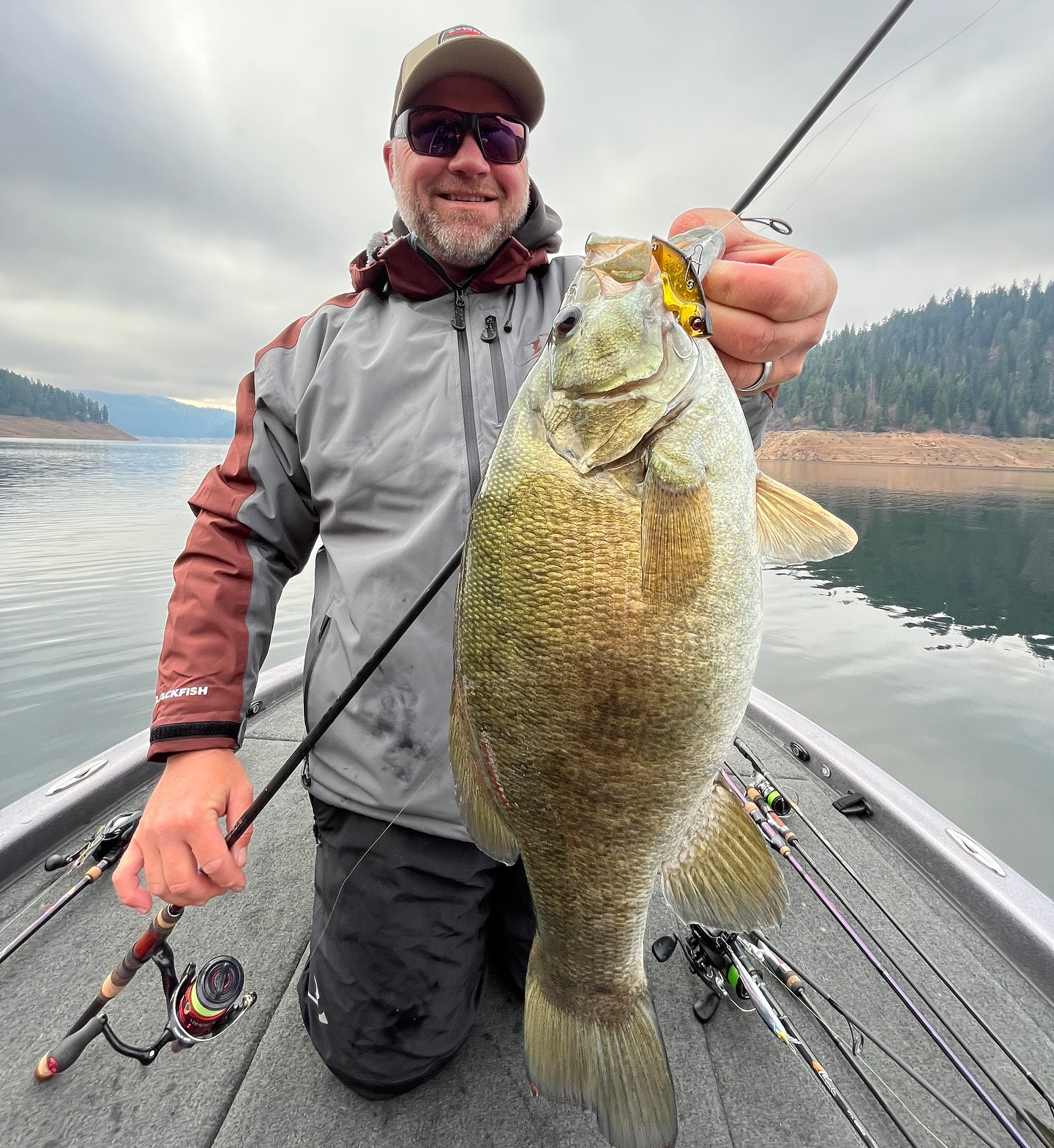Clausen shares simple approach for catching cold-water smallmouth

The waters near Bass Pro Tour angler Luke Clausen’s hometown of Spokane, Washington, likely won’t make many people’s list of wintertime fishing destinations. But even as the air temperatures dip below freezing, Clausen can be found on the water throughout the tournament offseason, mining for bronze.
One of Clausen’s favorite late fall and winter pastimes is targeting deep-water smallmouth bass. To catch them, the Tackle Warehouse pro developed a simple approach requiring just a couple spinning rods and a handful of baits.
Once water temperatures dip below about 50 degrees, the Mercury pro stops throwing traditional smallmouth baits like a drop-shot or finesse swimbait. In their place, he picks up a Z-Man Scented Jerk ShadZ on a Dirty Jigs Guppy Head, as well as a metal bait — either a Deracoup tail spinner or a Keeburn blade bait, both made by Jackall.
Hottest new smallmouth bait excels in the cold

The Jerk ShadZ and similar do-nothing, minnow-style baits have exploded in popularity since Jeff Gustafson used the Jerk ShadZ to win the Bassmaster Classic last March. It’s become a fixture on smallmouth anglers’ decks year-round, but as was proven at the recent Toyota Series Championship presented by Simms, Clausen said it excels in colder conditions.
“Usually when that water starts to get down around 50 (degrees), that’ll really start to show itself better than a bottom bait or a swimbait — something that’s very neutral in action,” he said.
Unlike some anglers, Clausen rarely uses the bait as a vertical presentation. Instead, he casts it out over fishy-looking structure and retrieves it by slowly reeling and constantly shaking his rod tip — a technique known in some parts of the country as tight-lining. He often uses the method to locate schools of bass.
“That’s a really good bait to find fish, too, just because they get so close to the bottom, you can’t see a lot of the fish with our forward-facing sonar,” he said. “But as that comes across structure or underneath bait, fish will rise to it and appear. And even when they’re not biting, it’s a great tool to find fish.”
Clausen uses either the 3.5- or 5-inch models of the Jerk ShadZ, depending on the size of the forage he’s trying to imitate. Smelt and shiner are his two favorite colors. His jighead selection ranges from 1/8 to 3/8 ounce. He throws the rig on a 7-foot-2, medium, extra fast Phenix M1 spinning rod spooled with 10-pound Seaguar Smackdown braided line and an 8-pound Seaguar Tatsu fluorocarbon leader.
Using metal to catch bronze
As winter continues to progress, Clausen leans more on the blade bait and tail spinner. When plying water in the low 40s (and sometimes even colder), metal is one of the few materials that can get down to the fish and continue to swim properly.
“We’ll see times we fish in the winter on some of this stuff up here that the water’s even in the upper 30s, and that’s really when pretty much the metal bait is the best way to catch them,” Clausen said. “Some days it’s the only thing you can catch them on.”
Once again, despite the frigid temperatures, Clausen isn’t afraid to use the baits to cover water. He makes long casts, letting his bait fall to the bottom and hopping it back to the boat.

Clausen uses the Deracoup in either the 3/8- or 1/2-ounce sizes. He throws the Keeburn almost exclusively in 1/2-ounce, the only exception being if the water is clear and the conditions calm and sunny. Then he’ll downsize to a 3/8-ounce offering. He swaps out the stock hooks on both baits in favor of Victory extra-wide gap trebles.
While the metal baits are heavy enough to be fished on casting gear, Clausen prefers to stick to his same spinning rod. The small diameter of his 10-pound braided mainline allows him to maintain a more direct connection to the bait in water as deep as 50 feet, and he finds spinning gear easier to manage when fishing in sub-freezing conditions. The only change he makes from his Jerk ShadZ setup is upsizing his leader with 12- or 15-pound Seaguar Tatsu.
“With a heavier leader, they foul a lot less,” Clausen explained. “You end up with hooks over your line with a lighter line a lot more often, with a lighter fluorocarbon. So I just use a little bit stiffer leader like that to prevent fouling.”
Finding the motherlode
The challenge of cold-water smallmouth fishing often isn’t getting bass to bite, but finding them. Smallmouth are notorious for lying flush with the bottom in cold conditions, making them difficult to locate even with top-of-the-line electronics. They tend to congregate in tight schools, too.
Clausen primarily utilizes his downscan and Lowrance ActiveTarget to search for cold-water smallmouth. ActiveTarget helps him see fish that show themselves when he swims the Jerk ShadZ above them. When he sees one, he knows there are typically more around.
Clausen usually starts by targeting points or other structure that have baitfish present, regardless of whether or not he can see bass. No matter if the primary forage in the fishery is alewives, perch or kokanee, Clausen looks for ambush points that top out around the same depth that baitfish are holding.
“The presence of bait is all too important,” he said. “That’s the biggest key to being around those fish, and certain sections of the lake a lot of times will have more bait that collide with these ambush points that these fish are using. … You want that bait to be at the same elevation as those. So if there’s bait in 80 (feet) but you’re trying to fish something that’s topped out at 30, it’s generally not as good as when you’re finding bait in areas that are in 20 or 30 foot of water that are outside of a point or a hump.”
If you think the winters get too cold to catch bass where you live, think again. As long as there’s open water and smallmouth nearby, use Clausen’s tips to keep catching fish throughout the proverbial offseason.